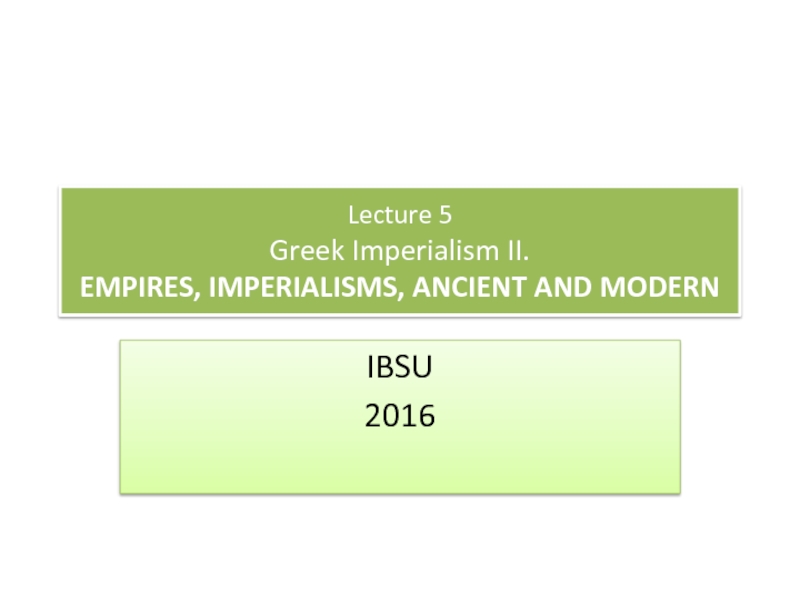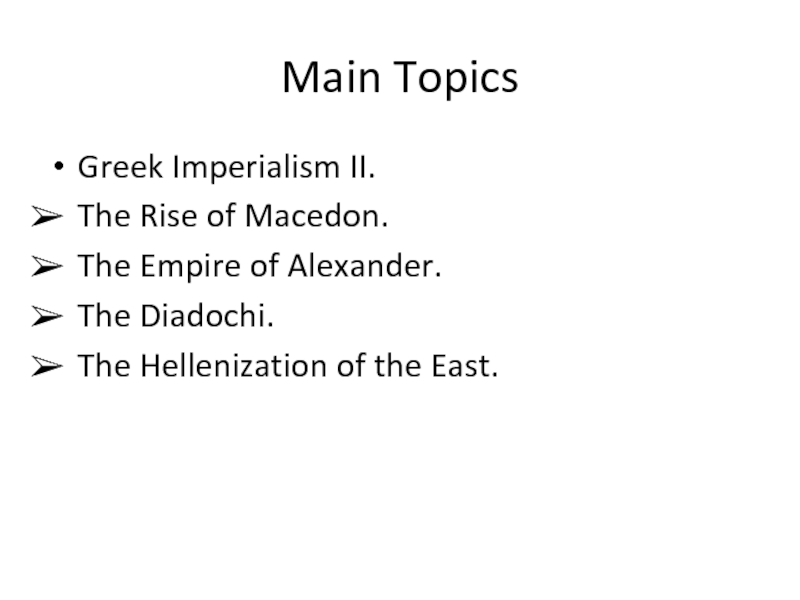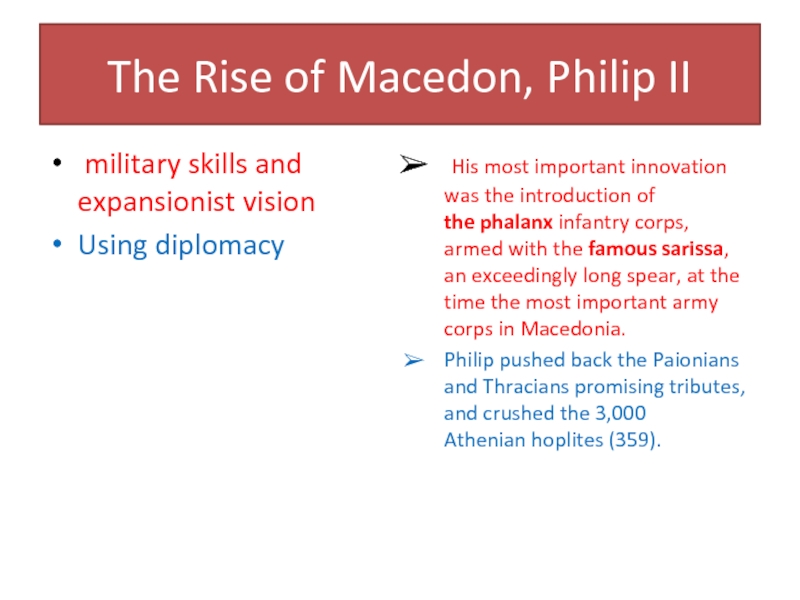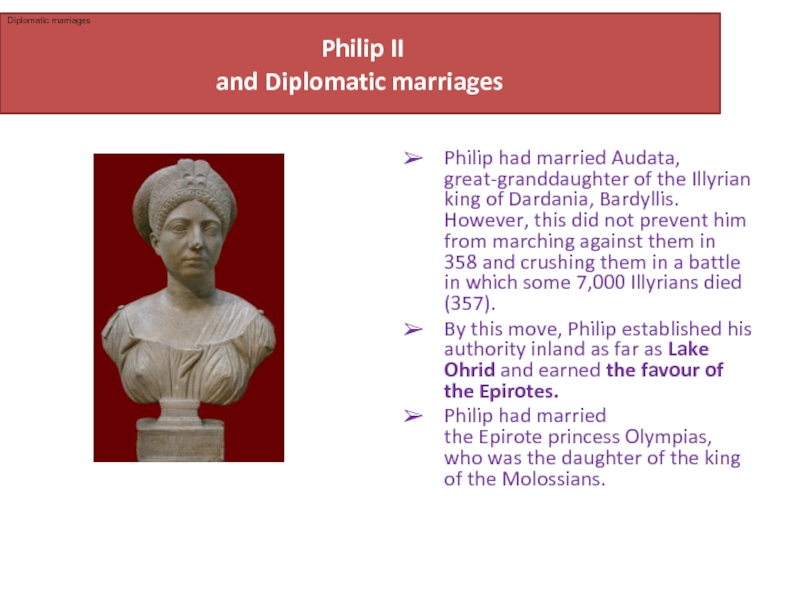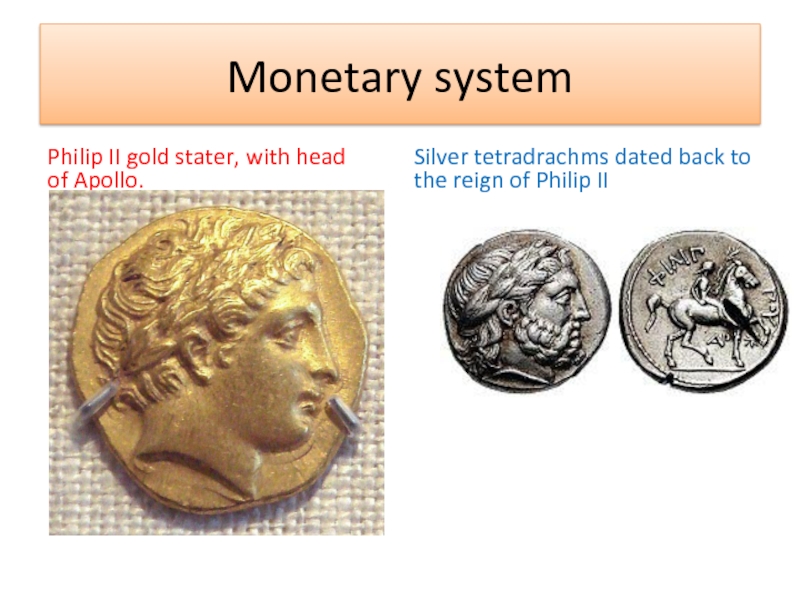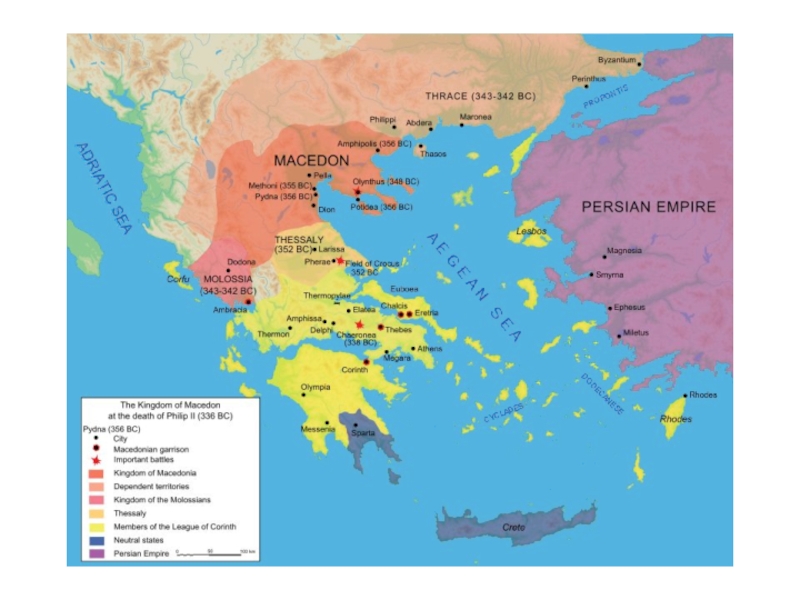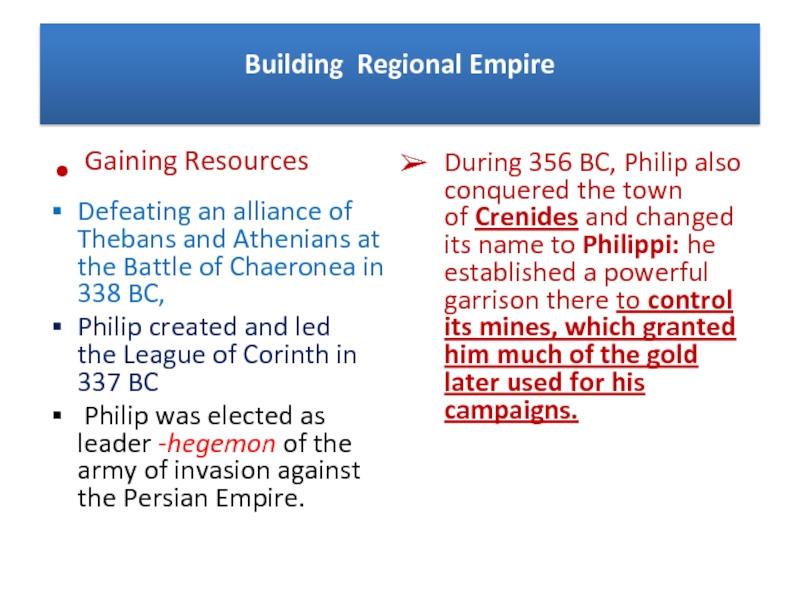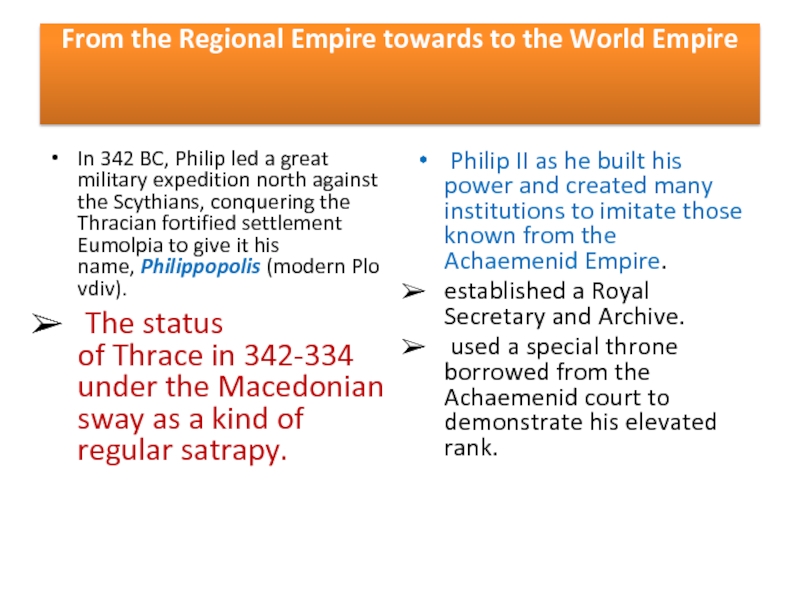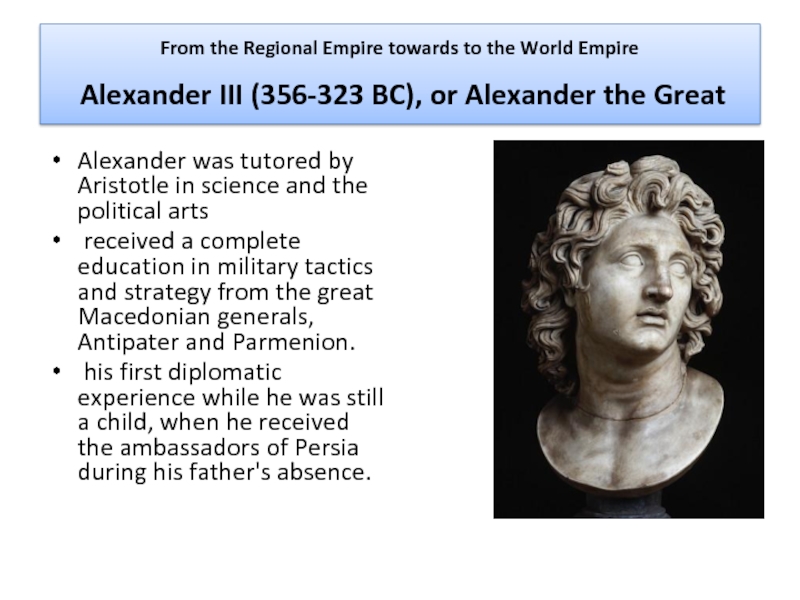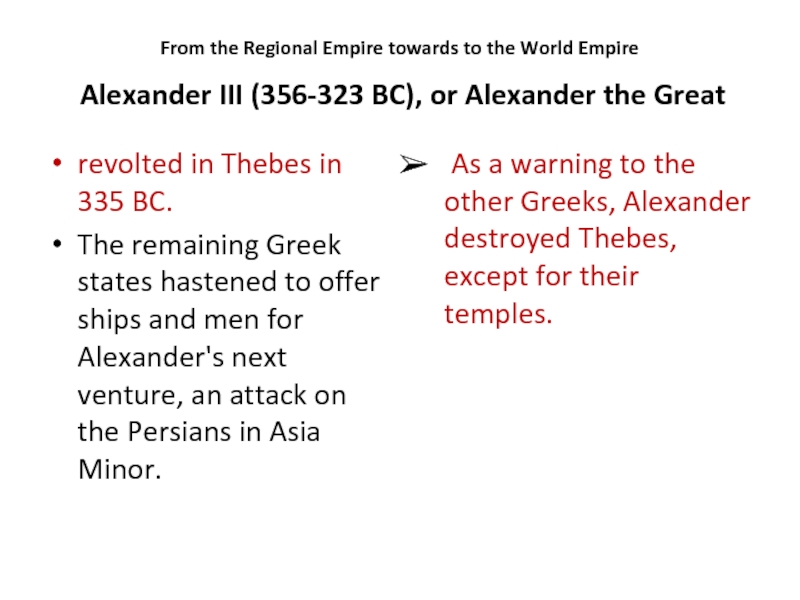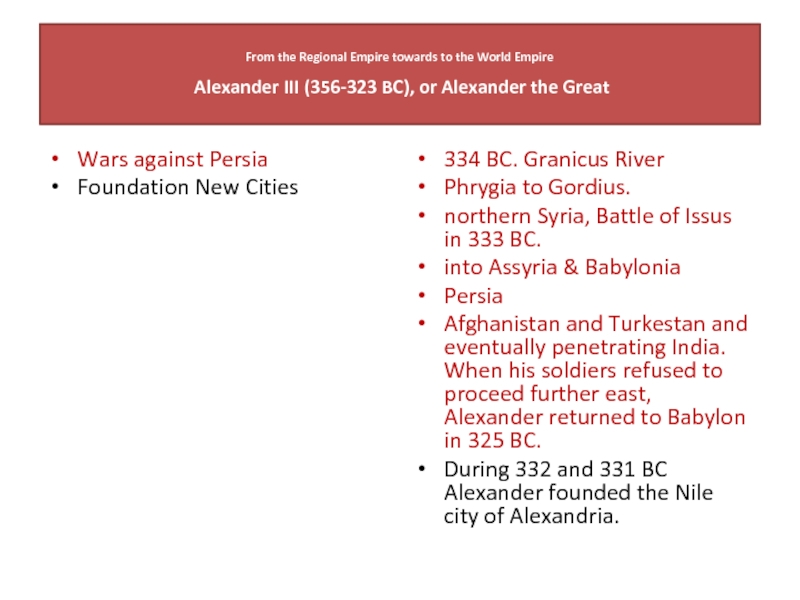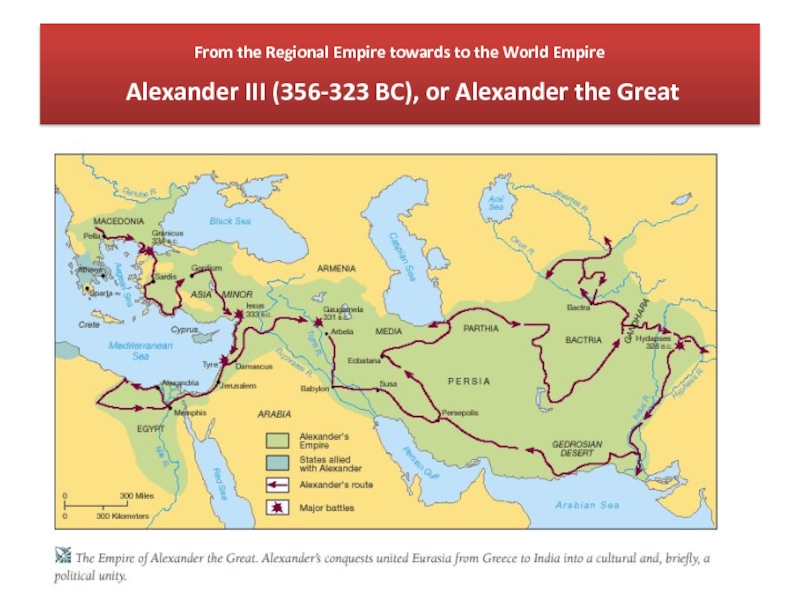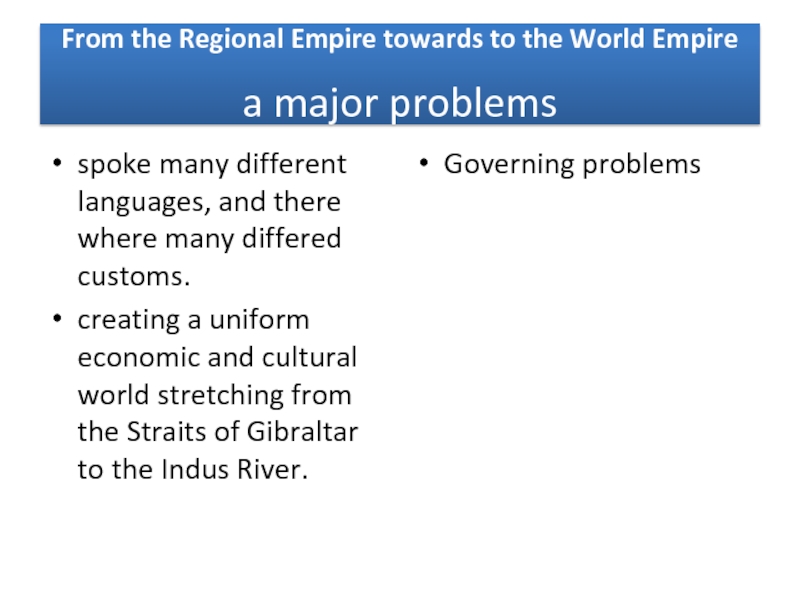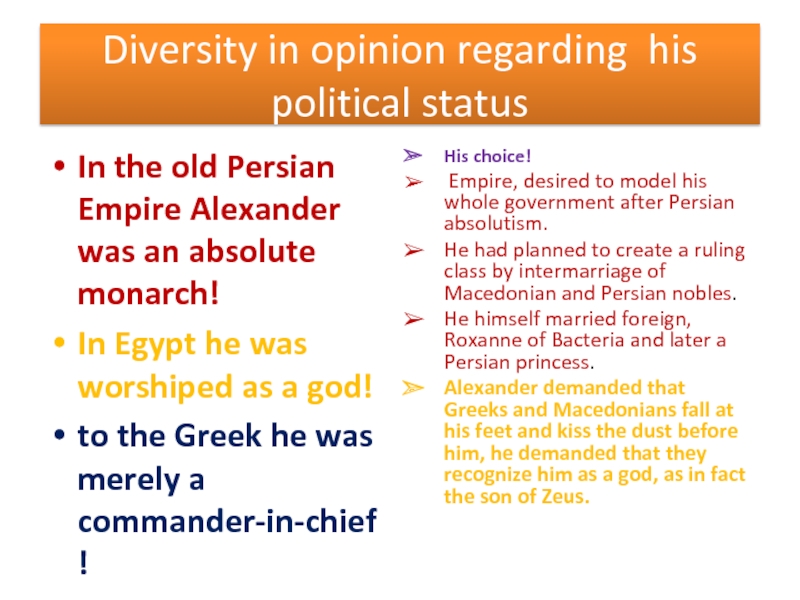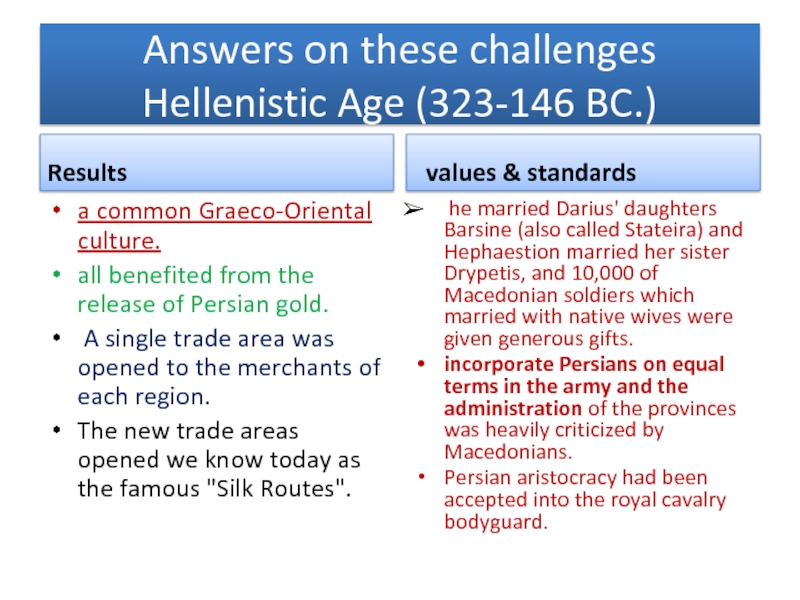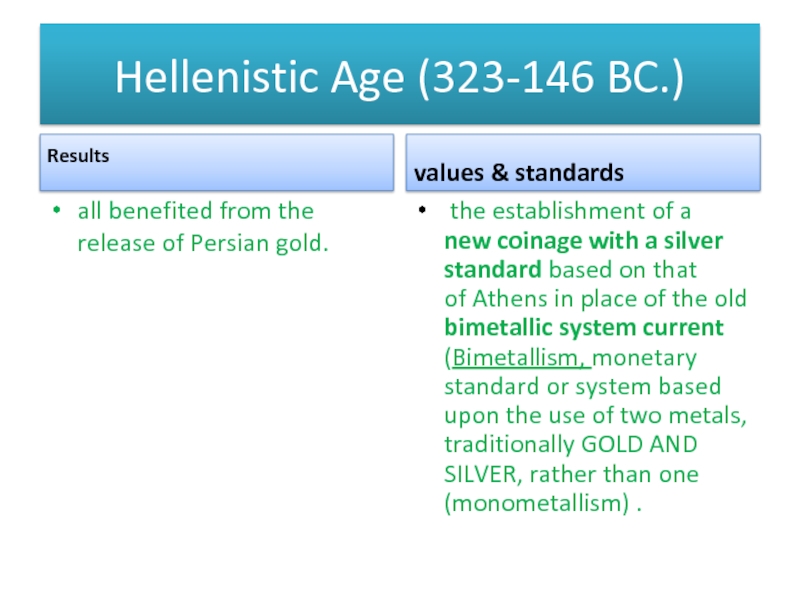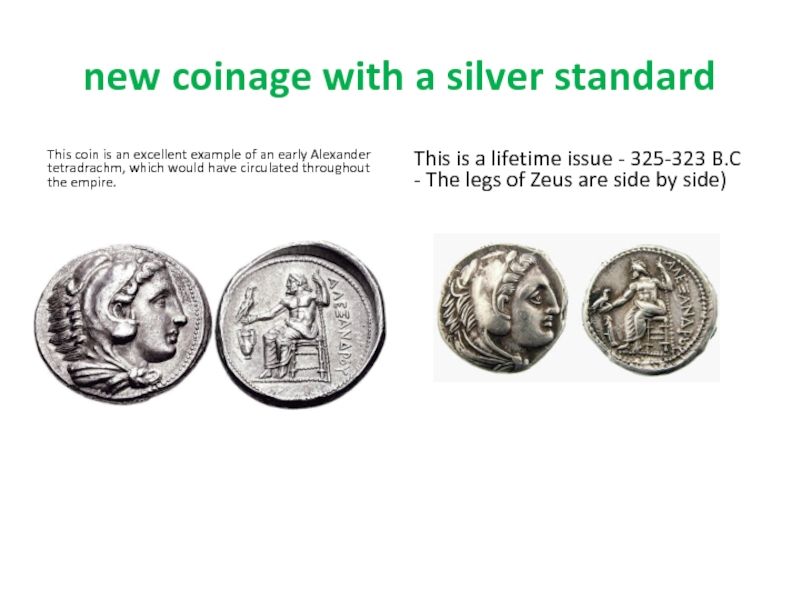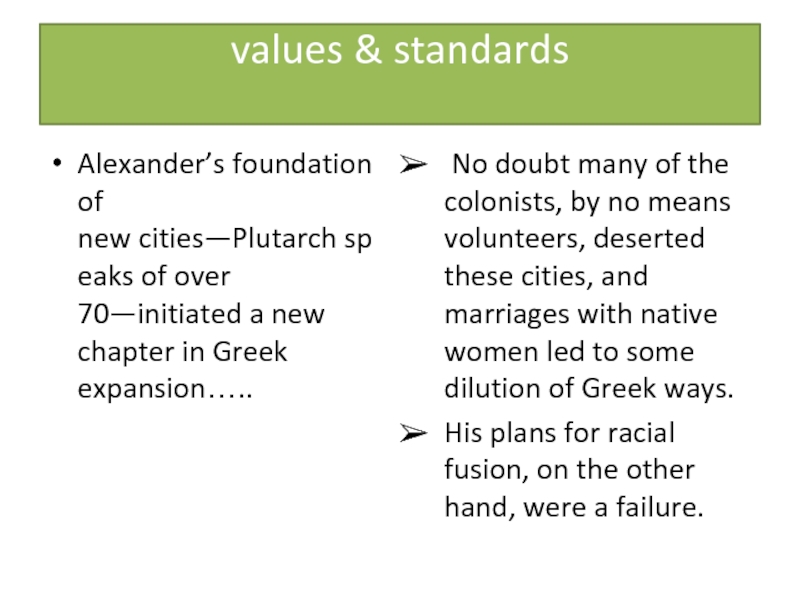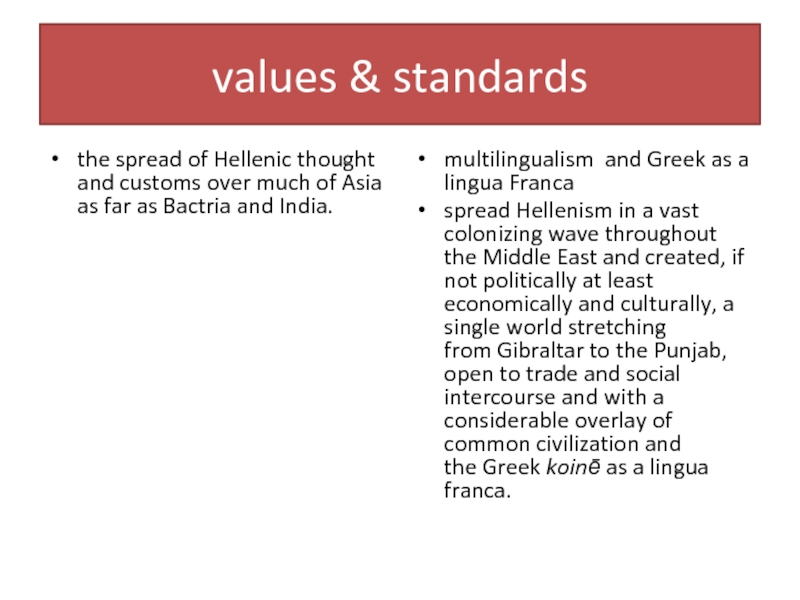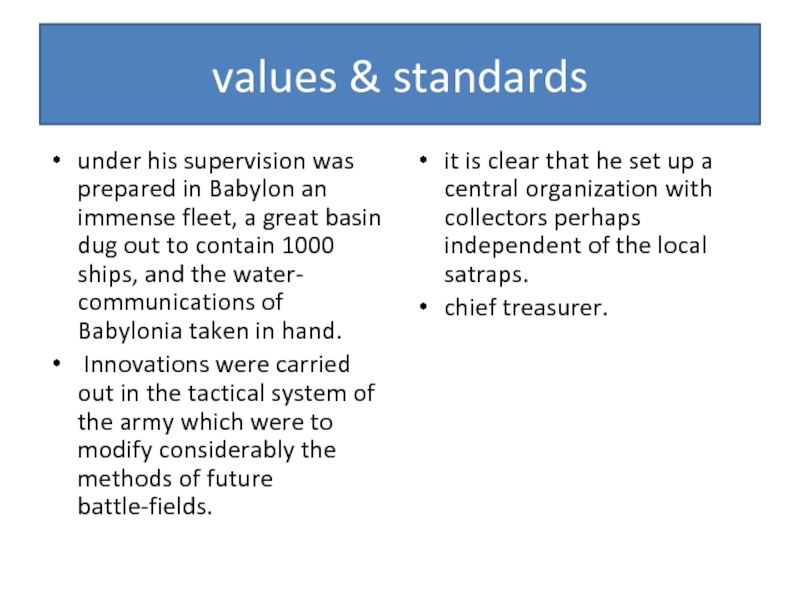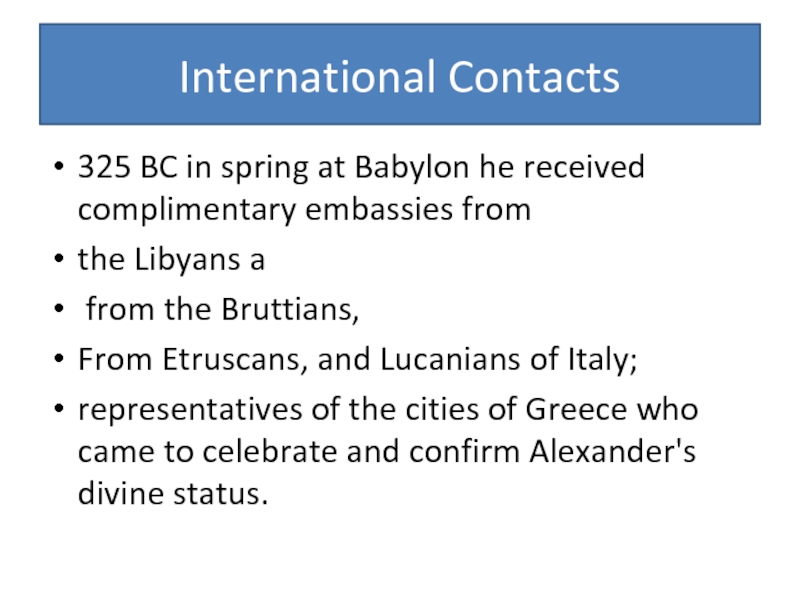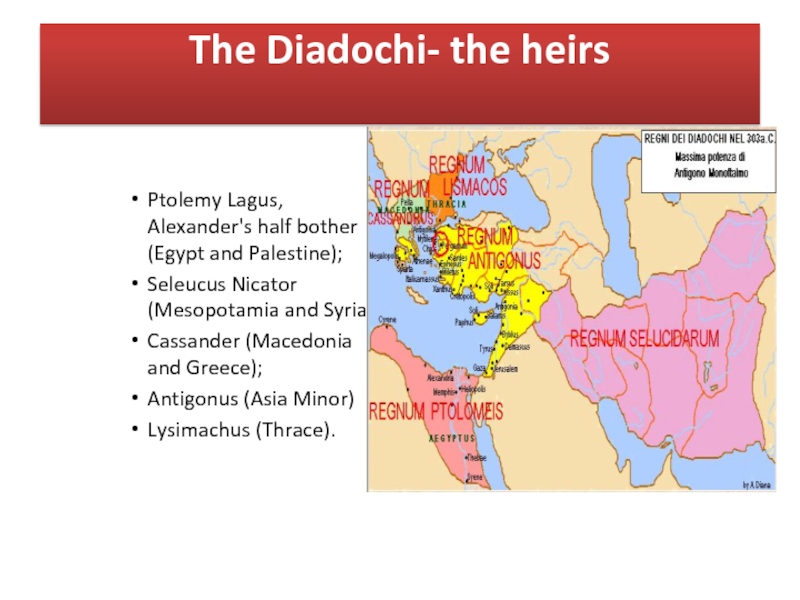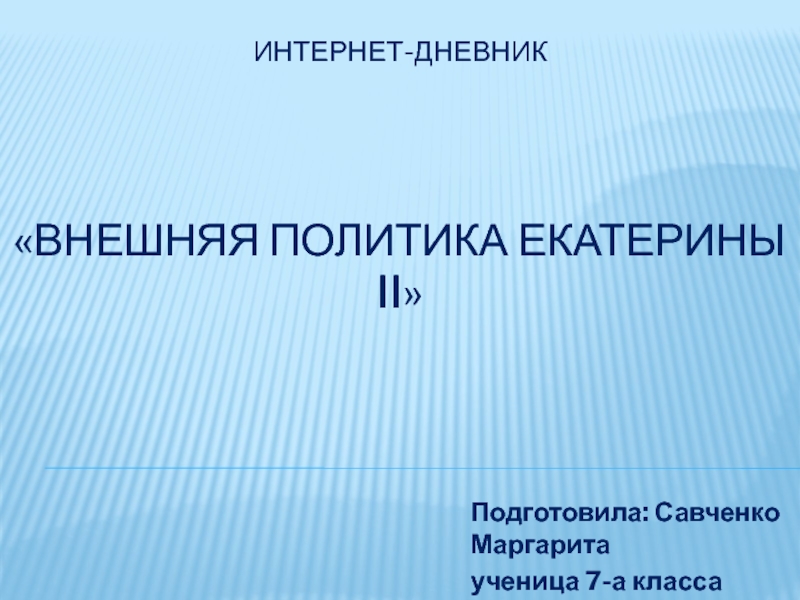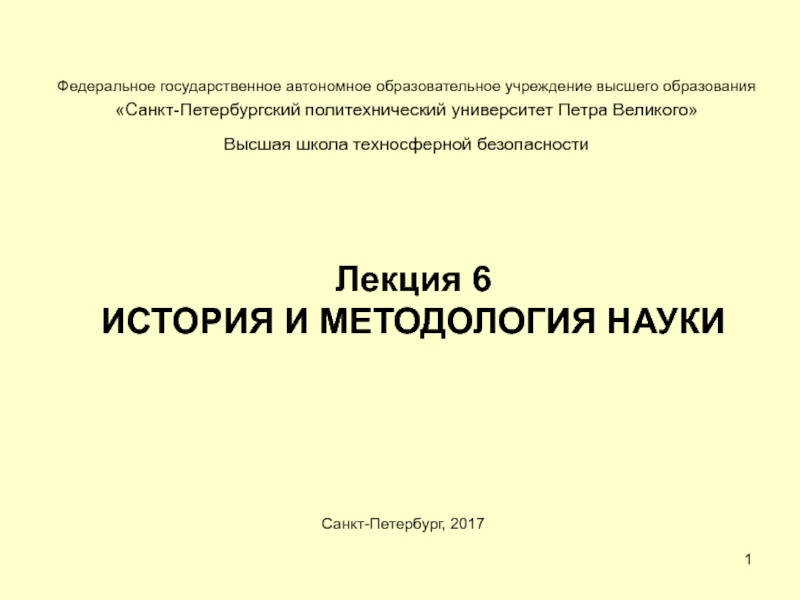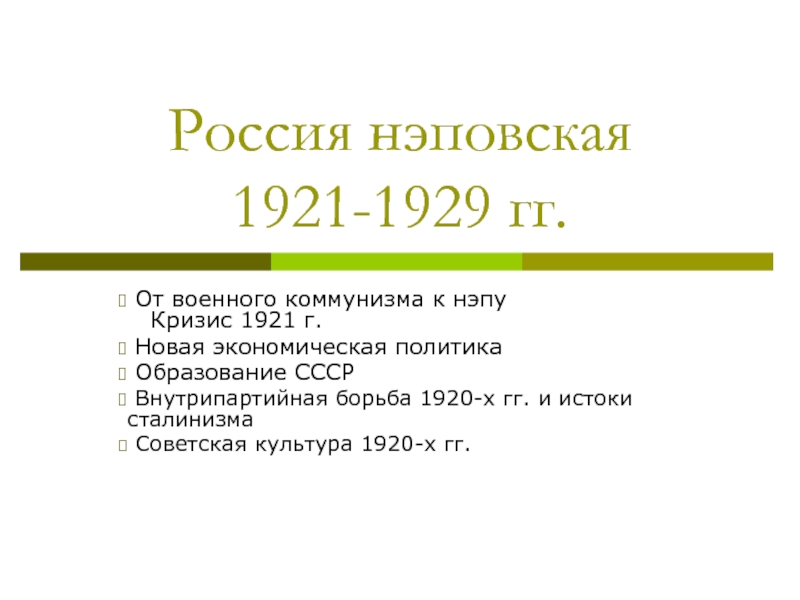- Главная
- Разное
- Дизайн
- Бизнес и предпринимательство
- Аналитика
- Образование
- Развлечения
- Красота и здоровье
- Финансы
- Государство
- Путешествия
- Спорт
- Недвижимость
- Армия
- Графика
- Культурология
- Еда и кулинария
- Лингвистика
- Английский язык
- Астрономия
- Алгебра
- Биология
- География
- Детские презентации
- Информатика
- История
- Литература
- Маркетинг
- Математика
- Медицина
- Менеджмент
- Музыка
- МХК
- Немецкий язык
- ОБЖ
- Обществознание
- Окружающий мир
- Педагогика
- Русский язык
- Технология
- Физика
- Философия
- Химия
- Шаблоны, картинки для презентаций
- Экология
- Экономика
- Юриспруденция
Greek imperialism. Empires, imperialisms, ancient and modern. (Lecture 5) презентация
Содержание
- 1. Greek imperialism. Empires, imperialisms, ancient and modern. (Lecture 5)
- 2. Main Topics Greek Imperialism II. The Rise
- 3. The Rise of Macedon, Philip II
- 4. The Rise of Macedon, Philip II
- 5. Philip II and Diplomatic
- 6. Monetary system Philip II gold stater, with head
- 8. Building Regional Empire Gaining
- 9. From the Regional Empire towards to the
- 10. From the Regional Empire towards to the
- 11. From the Regional Empire towards to the
- 12. From the Regional Empire towards to the
- 13. From the Regional Empire towards to the
- 14. From the Regional Empire towards to the
- 15. Diversity in opinion regarding his political status
- 16. Answers on these challenges Hellenistic Age (323-146
- 17. Hellenistic Age (323-146 BC.) Results
- 18. new coinage with a silver standard This coin is an
- 19. values & standards Alexander’s foundation of
- 20. values & standards the spread of Hellenic thought and
- 21. values & standards under his supervision was
- 22. International Contacts 325 BC in spring at
- 23. The Diadochi- the heirs
Слайд 2Main Topics
Greek Imperialism II.
The Rise of Macedon.
The Empire of Alexander.
The Diadochi.
The
Слайд 3The Rise of Macedon, Philip II
He was a member of
Слайд 4The Rise of Macedon, Philip II
military skills and expansionist vision
Using
His most important innovation was the introduction of the phalanx infantry corps, armed with the famous sarissa, an exceedingly long spear, at the time the most important army corps in Macedonia.
Philip pushed back the Paionians and Thracians promising tributes, and crushed the 3,000 Athenian hoplites (359).
Слайд 5
Philip II
and Diplomatic marriages
Philip had married Audata, great-granddaughter of the Illyrian
By this move, Philip established his authority inland as far as Lake Ohrid and earned the favour of the Epirotes.
Philip had married the Epirote princess Olympias, who was the daughter of the king of the Molossians.
Diplomatic marriages
Слайд 6Monetary system
Philip II gold stater, with head of Apollo.
Silver tetradrachms dated back to the reign
Слайд 8
Building Regional Empire
Gaining Resources
Defeating an alliance of Thebans and Athenians
Philip created and led the League of Corinth in 337 BC
Philip was elected as leader -hegemon of the army of invasion against the Persian Empire.
During 356 BC, Philip also conquered the town of Crenides and changed its name to Philippi: he established a powerful garrison there to control its mines, which granted him much of the gold later used for his campaigns.
Слайд 9From the Regional Empire towards to the World Empire
In 342 BC,
The status of Thrace in 342-334 under the Macedonian sway as a kind of regular satrapy.
Philip II as he built his power and created many institutions to imitate those known from the Achaemenid Empire.
established a Royal Secretary and Archive.
used a special throne borrowed from the Achaemenid court to demonstrate his elevated rank.
Слайд 10From the Regional Empire towards to the World Empire Alexander III
Alexander was tutored by Aristotle in science and the political arts
received a complete education in military tactics and strategy from the great Macedonian generals, Antipater and Parmenion.
his first diplomatic experience while he was still a child, when he received the ambassadors of Persia during his father's absence.
Слайд 11From the Regional Empire towards to the World Empire Alexander III
revolted in Thebes in 335 BC.
The remaining Greek states hastened to offer ships and men for Alexander's next venture, an attack on the Persians in Asia Minor.
As a warning to the other Greeks, Alexander destroyed Thebes, except for their temples.
Слайд 12From the Regional Empire towards to the World Empire Alexander III
Wars against Persia
Foundation New Cities
334 BC. Granicus River
Phrygia to Gordius.
northern Syria, Battle of Issus in 333 BC.
into Assyria & Babylonia
Persia
Afghanistan and Turkestan and eventually penetrating India. When his soldiers refused to proceed further east, Alexander returned to Babylon in 325 BC.
During 332 and 331 BC Alexander founded the Nile city of Alexandria.
Слайд 13From the Regional Empire towards to the World Empire Alexander III
Слайд 14From the Regional Empire towards to the World Empire a major problems
spoke many different languages, and there where many differed customs.
creating a uniform economic and cultural world stretching from the Straits of Gibraltar to the Indus River.
Governing problems
Слайд 15Diversity in opinion regarding his political status
In the old Persian Empire
In Egypt he was worshiped as a god!
to the Greek he was merely a commander-in-chief!
His choice!
Empire, desired to model his whole government after Persian absolutism.
He had planned to create a ruling class by intermarriage of Macedonian and Persian nobles.
He himself married foreign, Roxanne of Bacteria and later a Persian princess.
Alexander demanded that Greeks and Macedonians fall at his feet and kiss the dust before him, he demanded that they recognize him as a god, as in fact the son of Zeus.
Слайд 16Answers on these challenges
Hellenistic Age (323-146 BC.)
Results
a common Graeco-Oriental culture.
all benefited from the release of Persian gold.
A single trade area was opened to the merchants of each region.
The new trade areas opened we know today as the famous "Silk Routes".
values & standards
he married Darius' daughters Barsine (also called Stateira) and Hephaestion married her sister Drypetis, and 10,000 of Macedonian soldiers which married with native wives were given generous gifts.
incorporate Persians on equal terms in the army and the administration of the provinces was heavily criticized by Macedonians.
Persian aristocracy had been accepted into the royal cavalry bodyguard.
Слайд 17Hellenistic Age (323-146 BC.)
Results
all benefited from the release of Persian gold.
values
the establishment of a new coinage with a silver standard based on that of Athens in place of the old bimetallic system current (Bimetallism, monetary standard or system based upon the use of two metals, traditionally GOLD AND SILVER, rather than one (monometallism) .
Слайд 18new coinage with a silver standard
This coin is an excellent example of an early
This is a lifetime issue - 325-323 B.C - The legs of Zeus are side by side)
Слайд 19values & standards
Alexander’s foundation of new cities—Plutarch speaks of over 70—initiated a new
No doubt many of the colonists, by no means volunteers, deserted these cities, and marriages with native women led to some dilution of Greek ways.
His plans for racial fusion, on the other hand, were a failure.
Слайд 20values & standards
the spread of Hellenic thought and customs over much of Asia
multilingualism and Greek as a lingua Franca
spread Hellenism in a vast colonizing wave throughout the Middle East and created, if not politically at least economically and culturally, a single world stretching from Gibraltar to the Punjab, open to trade and social intercourse and with a considerable overlay of common civilization and the Greek koinē as a lingua franca.
Слайд 21values & standards
under his supervision was prepared in Babylon an immense
Innovations were carried out in the tactical system of the army which were to modify considerably the methods of future battle-fields.
it is clear that he set up a central organization with collectors perhaps independent of the local satraps.
chief treasurer.
Слайд 22International Contacts
325 BC in spring at Babylon he received complimentary embassies
the Libyans a
from the Bruttians,
From Etruscans, and Lucanians of Italy;
representatives of the cities of Greece who came to celebrate and confirm Alexander's divine status.
Слайд 23The Diadochi- the heirs
Ptolemy Lagus, Alexander's half bother (Egypt and
Seleucus Nicator (Mesopotamia and Syria);
Cassander (Macedonia and Greece);
Antigonus (Asia Minor)
Lysimachus (Thrace).
